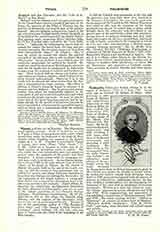

Tiraboschi, GIROLAMO, Italian scholar, b. in the region of Bergamo, 1731; d. June 3, 1794. At an early age he entered the Society of Jesus. After serving as professor of rhetoric and belles-lettres (eloquenza) at the Brera in Milan, he was called by
Francesco III, Duke of Modena, to take charge of his library (the Biblioteca Estense); this he directed with patient Endeavor and skill, enriching it with many additions of books and manuscripts and providing it with catalogues. His chief work is the monumental “Storia della letteratura italiana”, an exhaustive compilation of the materials within his reach. Actuated by the patriotic desire to defend his country’s glory in the cultural arts against the attacks of foreign critics, he makes his history extend from Etruscan times down to 1700, and concerns himself with all matters of interest in belles-lettres, philosophy, history, the fine arts, medicine, jurisprudence, etc., accompanying the statement of his views with an abundance of precious documents. Written in a clear and attractive style, the “Storia” appeared in its first edition between 1772 and 1782. With augmentations and connections, it was published a second time at Modena, between 1787 and 1794. His minor writings include: “Biblioteca Modenese”, an account of writers born in Modena; “Memorie storiche modenesi”; “Vita di Fulvio Testi”; and many other historical and critical essays and articles.
J. D. M. FORD

